Finding the money to develop rental homes affordable for low-income families has never been more difficult. The collapse of the financial markets last fall, generally attributed to systemic failures in the single-family mortgage markets, has made it extremely difficult for most developers to obtain debt and equity financing on reasonable terms.
As a result, thousands of affordable apartments slated to begin construction in California in the first half of 2009 are stalled, awaiting financing that some fear may never come. Furthermore, thousands of construction-related jobs have been lost at a time when unemployment in our state has hit levels not seen since the 1970s.1
However, the desire of President Obama’s new administration and leaders in Congress to undertake serious steps to stem global warming may provide a singular opportunity to make more visible the role rental housing can play in making our country’s infrastructure greener. But this can only happen if we are willing to invest some of that old fashioned kind of green (as in dollars) to do it. As a side benefit, we can produce thousands more eco-friendly homes and jobs in the process.
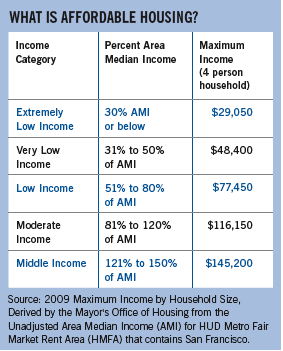
Permanently affordable subsidized rental housing is targeted
at households earning 60 percent of the Area Median Income
or below.
The problem facing affordable housing today
It is ironic that fears over investment losses in the for-sale market have resulted in a dramatic reduction in investments in the development of affordable rental housing. At a time when millions of additional households are being forced to enter the rental market — generally creating significant pressure on vacancy rates, which have kept rental rates relatively high in most coastal housing markets in California despite widespread job losses — these fears only exacerbate the situation.
The shortage of capital combined with market fears has eroded the traditional relationship between risk and return, sending returns for the few remaining investors skyrocketing even as the fundamentals of the rental real estate market hold steady. Normally, a developer’s cost of financing is based on the market’s perception of the likelihood of repayment in combination with the interest rate or rate of return charged. Financial institutions traditionally have set the cost of financing the development of a rental property based on a variety of risk factors, including the rental and vacancy rates and the track record and capacity of the developer. They generally have offered lower cost financing to a larger developer with a strong track record building housing in a desirable neighborhood with rising rents and a low vacancy rate, and a higher rate to a smaller developer working in an area with flat or decreasing rents due to increasing vacancy rates or deteriorating physical or market conditions.
On the other hand, banks financing rental housing affordable to lower-income households have had strong incentives to keep the costs they charge as low as possible because of often intense competition for this business, particularly in the case of developments that qualify for credit under their Community Reinvestment Act obligations.2 The demand for CRA qualified investments had gotten so strong before the collapse of the financial markets that savvy developers working in most California markets could count on a dozen or more financial institutions competing for their business. The result of this competition had been to drive down the cost of financing, making it easier for developers to achieve affordable rents and leading to increased production of affordable rental housing.
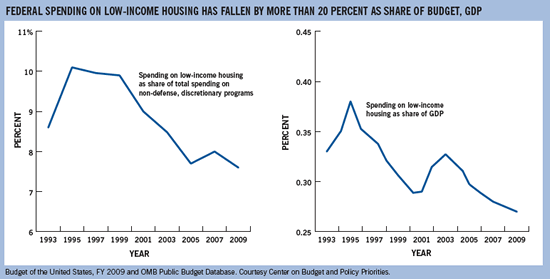
However, as the financial markets crisis led to the demise of a number of major financial institutions and created a severe shortage in the supply of credit, the margin or spread that investors have demanded — even for CRA qualified investments — has more than doubled, and in some cases tripled, over comparable term investments in no-risk U.S. Treasury securities. This change has come despite the fact that there has been no documented increase in foreclosures or defaults in investments in affordable rental housing.
One example of the severe shrinkage in capital available and its consequences to financing the development of affordable rental housing is the dramatic change in the market for investing in the Low Income Housing Tax Credit. The Low-Income Housing Tax Credit is the nation’s largest and most successful affordable rental housing production program, having financed more than 2 million homes since 1987 and more than 120,000 annually in recent years.3 Approximately 90 percent of all affordable rental housing is financed through the LIHTC.4
Two years ago, the national volume of investments in LIHTCs was estimated at more than $9 billion. By the end of 2008, this had shrunk by half to $4.5 billion. This year, the volume of investments is projected to shrink further to less than $3 billion. The few investors remaining in the market are taking full advantage of their leverage, demanding increases in their internal rate of returns — from the 4 percent to 5 percent level seen just two years ago, to 10 percent to 14 percent today.5
The production of affordable rental homes in California has been particularly hard hit. The rapid decline in state tax revenues (related in part to the collapse of the financial markets) exacerbated the existing structural imbalance between revenues and expenses in our state budget, causing the few remaining investors in the market to lose interest in purchasing California state-issued bonds — at least temporarily. This in turn triggered a state freeze in December on funding voter-approved rental housing bond programs, such as the Multi-family Housing Program. This forced the state Department of Housing and Community Development to delay many loan closings, and until recently to suspend making promised new commitments for most rental housing production programs. While the department recently issued new commitments for voter-approved bond programs for the first time since December, it is clear that there is still not enough cash available from state bond sales to ensure timely payment of existing and planned commitments.
While many of us would like to think that these are temporary changes that a combination of short-term federal interventions and gradual improvements to the financial markets will reverse in short order, others of us are not so sure that it isn’t time to fundamentally reassess the way we finance the production of rental housing for lower income households and the role that the federal government plays in this system, which under its current configuration has led to funding for housing coming under increasing budgetary pressure even in years when “housing-friendly” administrations are in power.
Any reassessment of our rental housing finance system and what should come next, however, should first begin with an understanding of what has come before. At the risk of vast oversimplification, it is valuable to briefly summarize the history of the dominant trends in affordable housing rental finance.
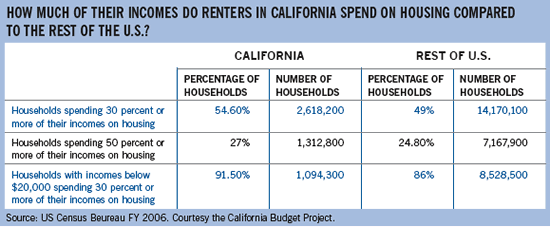
The First Wave: Direct Housing Production by Government
The 1930s saw the beginning of the modern era of affordable housing production, with programs providing direct government funding and ownership of housing for poor people.6 Much of the nation’s public housing was built in this way during the three succeeding decades, either through the Public Housing program directly or as a byproduct of wartime worker housing, such as that built in and around San Francisco’s Hunters Point Shipyard. While much of this early public housing lacks the architectural detail and amenities of today’s more modern version, it generally was built quickly and efficiently, and it provided much needed affordable shelter to more than 1 million households nationally, including more than 40,000 in California.
But public housing’s exclusion of private enterprise and mixed-income populations left it more vulnerable politically than most federal housing programs to attacks by the fiscal conservatives of the Bush era, who succeeded in dramatically cutting funding levels for public housing from 2001-2008, undercutting some of the more promising (if imperfect) reform efforts.7 By encouraging Congress to cut funding for public housing below sustainable levels and destabilizing funding for the housing choice voucher program, the Bush administration essentially attempted to end these reform efforts in favor of state block grants. Ultimately, a bipartisan coalition in Congress rejected this approach, but deep damage had been done. The Center on Budget and Policy Priorities estimated in 2008 that thanks to the additional deferred maintenance accrued during this era, the cost of restoring and replacing this older public housing stock now exceeds $30 billion nationally.
The Second Wave: Mortgage and Operating Subsidies for Private Developers
Beginning in the 1960s and continuing in the 1970s and early 1980s, the federal Department of Housing and Urban Development experimented with providing a variety of incentives to private developers to build housing for lower income families through subsidized mortgages and long-term rental housing subsidy contracts. These federal rent subsidies help fill the financial gap between the market rate rent for a unit and the amount a low income family could afford to pay using no more than 30 percent of its income, which Congress had agreed should be the standard for whether a rent level is affordable.
More than 1 million affordable homes were created through these programs nationally. California ended up with a stock of 150,000 of these rental apartments, serving predominantly extremely low and very low income families. Unfortunately, in return for providing these deep subsidies, some of which were the equivalent of 100 percent debt financing, the federal government got only a 20-year commitment to affordability: With few exceptions, most private owners were given the right to end the use restrictions after this initial 20-year period. This led — predictably, in hindsight — to a series of struggles among private owners and local governments and tenant advocates about the conditions under which owners could convert their properties to market.
HUD’s role in providing large-scale direct production incentives through mortgage and rent subsidies came to an end during the first term of President Reagan and has never regained enough political support to be rekindled on any significant scale. Fortunately some cities, including San Francisco, New York and Chicago, have been able to preserve most of their stock of HUD-subsidized privately owned housing through the work of public funding agencies and nonprofit affordable housing developers.
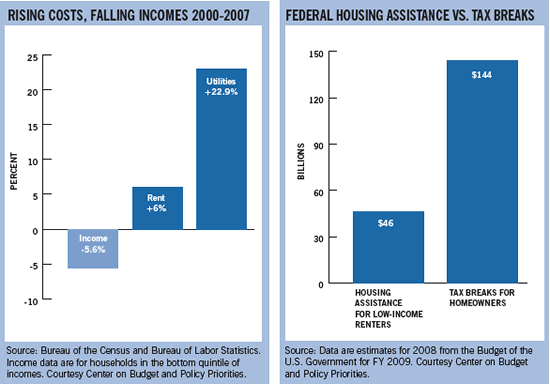
Incomes of lower-income families have not kept pace with the cost of housing. Spending on low-income housing assistance is one-third the amount of federal subsidies for homeowners.
The Third Wave: Vouchers for the Private Market
While the 1970s and early 1980s saw the end of direct federal funding of rental housing production, 1974 witnessed the birth of a new program to provide low-income families with vouchers enabling them to pay market rent. Under the Section 8 voucher program, now known as the Housing Choice Voucher program, HUD offered a limited number of vouchers to local public housing authorities for use by eligible low-income households that agree to pay 30 percent of their income as their contribution toward renting an apartment. Households lucky enough to obtain a Section 8 voucher take them to a private landlord willing to take the vouchers in lieu of rent from the tenant. The ability to take the voucher to any landlord has led people to refer to it as a tenant-based subsidy, in contrast to place-based ones like subsidized FHA mortgages and Section 8 contracts that are tied to specific properties and owners. Supporters of the voucher program, including many self-described fiscal conservatives who were critics of HUD’s direct production subsidy programs, claimed that it would stimulate private housing production by increasing the demand for market-rate rental apartments.
As a production program, the Section 8 voucher program has been a failure. No one has been able to document persuasively that the tenant-based voucher program has resulted in increased private sector production of rental housing. The reasons for this failure are complicated, but can be boiled down to one statement: the offer of market comparable rents promised by the voucher program is generally not sufficient incentive to motivate developers to build new rental housing. In other words, developers make the decision to build or not build more apartments regardless of whether they think they can attract voucher holders. Even in Los Angeles, which has more vouchers than any city other than New York, there is no evidence that the presence of the voucher program has resulted in the production of any additional apartments.8
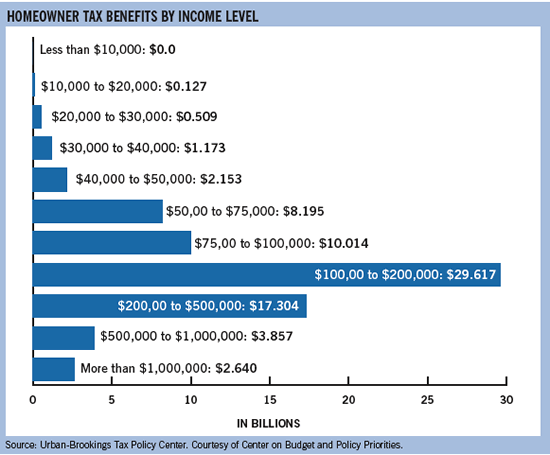
Tax benefits from the Home Interest Deduction favor those with higher incomes.
But the real story of the Section 8 voucher program is that while it has failed in its goal of stimulating production, it has succeeded beyond its authors’ wildest dreams in serving as a housing safety net for anyone lucky enough to get into the program. It has been a godsend for the 2 million households lucky enough to obtain a voucher, of which 300,000 are in California. This is why providing additional federal funding to expand the voucher program has become one of the top priorities for progressive low-income advocates such as the National Low Income Housing Coalition and the Center on Budget and Policy Priorities.
But despite their relative popularity in Washington, D.C., tenant-based vouchers have real limits to their usefulness in high-cost housing markets such as San Francisco. In these expensive markets, the rents authorized by HUD and offered by the local housing authority often are not enough to persuade private landlords to participate. As a result, as many as 50 percent of voucher recipients in high-cost, low-vacancy areas such as San Francisco are forced to give back their vouchers because they cannot find landlords willing to take the rents limited by HUD formula. Vouchers are only a good long-term solution in such low-vacancy higher cost rental markets if they are accompanied by other programs to stimulate production.
The Fourth Wave: Financing through Public/Private Partnerships
The passage of the Tax Reform Act of 1986 heralded the arrival of a new financing tool, the Low Income Housing Tax Credit. Under the LIHTC program, corporate investors purchase tax credits usable over a 10-year period in return for an equity investment that generally is funded at the time the buildings begin serving low-income households.
Initially, corporate fears about the risks of owning and operating low-income housing kept demand low. Consequently, corporate investors reaped returns in the 25 percent range annually. This translated into the property receiving roughly 50 cents for each dollar of tax credit the investor received and raised questions about the efficiency of the program. Thanks to a remarkably low rate of operating problems — a default rate of less than 0.1 percent over the past 20 years — and the arrival in the late 1980s of strong incentives for financial institutions to invest in LIHTCs provided through the Community Reinvestment Act legislation, corporate profits made in purchasing LIHTCs plummeted throughout the 1990s until they reached a level in the middle part of this decade where investors often paid more than $1 for each dollar of tax credits received.9
While it is possible that investor demand may return to levels approaching this historic high point of market efficiency, the current crisis in the financial markets has raised serious questions about whether this will be enough to bring LIHTC rental housing production levels back to where they were prior to the crisis (approximately 130,000 new affordable apartments annually, according to the National Council of State Housing Agencies).
The future: Investing in Green Affordable Rental Housing
While the future of affordable housing finance is far from clear, two trends appear to be developing at a federal level that are worth some attention. The first is that the level of direct investment by the federal government in rental housing production per se is unlikely to grow significantly, due to serious budgetary constraints that will severely limit the scope of any new housing initiatives that either the Obama administration or Congress might otherwise propose. Witness the current struggle to find seed money for the National Housing Trust Fund, the most important new production tool for low-income housing in the past quarter century.
The rising cost of health care, retirement programs. debt service and foreign interventions is gradually absorbing more and more of the federal government’s discretionary spending, to the point where we will be lucky if the HUD budget, currently funded at about $45 billion, keeps pace with inflation over the next decade. This does not mean that the Obama administration will not propose important new housing initiatives, just that any such initiatives will be necessarily limited in financial scope. One example of this is the proposed $250 million Choice Neighborhoods Initiative in this year’s budget proposal.
The second clear trend is that that the Obama administration and Congressional leaders are committed to taking some action to combat global warming and involving HUD in the process.10 Several recent studies have shown that the housing stock in industrialized countries accounts for 20 percent to 27 percent of all carbon emissions.11 In other words, there is a clear incentive to reduce the carbon footprint of housing in any climate-change legislation, and since the government has significant leverage over the behavior of developers of affordable housing receiving federal subsidies, this is a logical place to start.
There are two ways that carbon emissions from housing can be reduced. One way is by locating housing closer to transportation, jobs and services, thereby reducing the number of vehicle miles traveled and the carbon emissions associated with them. The other is by recognizing that most of the nation’s older stock of affordable housing is already located close to jobs and transit12 but is very energy inefficient because of its age.
With tens of billions of dollars of capital repair needs already documented in older publicly and privately owned affordable housing — equipped with mostly antiquated heating and cooling systems and without proper insulation — there is a tremendous opportunity for advocates to make the case that investing in the greening of affordable rental housing is an essential part of our nation’s carbon reduction strategy. For example, homes in the Northeast built prior to 1970 use 30 percent more energy per square foot than homes built since 1990. Older homes are 20 percent to 25 percent less efficient on this basis in the South and Midwest and 10 percent less efficient in the West.13 If added incentive is needed for focusing on investing in reducing energy consumption in existing affordable rental housing, the Energy Programs Consortium reported in 2008 that lower-income households use 28 percent more energy per square foot than higher-income households primarily because they live in older, less energy-efficient homes and low income households represent almost one quarter of the homes in our country.14
An early indicator of how we can succeed in linking carbon emission reduction to reinvesting in our older housing serving lower-income households is some of the billions approved by Congress for this purpose in the American Recovery and Reinvestment Act of 2009, including $5 billion for weatherizing homes, $4 billion for reinvesting in aging public housing and $250 million to retrofit and green older privately assisted housing.
We must urge Congress to take this to the next level by setting aside a percentage of the carbon emission offsets to be invested in greening our nation’s older housing stock. One bill that takes this approach, the American Clean Energy and Security Act of 2009 (House resolution 2454), just passed the House of Representatives. Thanks in part to the efforts of U.S. Rep. Maxine Waters, the bill includes up to $65 million to retrofit older publicly and privately owned affordable rental housing. While this amount is a drop in the bucket given the scale of the opportunity, it does not diminish the potential for this source of revenue to grow in the future. The Senate is poised to introduce its own version of the bill in September and may well increase this funding significantly. This amount will inevitably grow larger over time as the fight against global warming increasingly takes center stage.
A related source of relatively untapped resources is federal transportation funding. Every five years, the federal government authorizes a massive transportation bill worth more than $50 billion per year, mostly for road improvements and smaller amounts for investments in public transit and related infrastructure. Congress has just begun debating the successor to the expiring previous transportation bill — the Safe, Accountable, Flexible, Efficient Transportation Equity Act, or SAFETEA. It appears that “smart growth” initiatives that minimize vehicle miles driven — and therefore carbon emissions — are gaining currency, and there is an opportunity to shift some of the highway funds, particularly the ones dedicated to expanding highways, to smart growth incentives.
In passing Proposition 1C in 2006 and authorizing the creation of the Transit Oriented Development and Infill Infrastructure Grant programs, California has already demonstrated the benefits of creating financial incentives to encourage the development of multi-family housing around transit and services. Despite some flaws, the TOD and IIG programs are succeeding at linking incentives for new smart growth development to the inclusion of affordable housing and leading to the creation of thousands of new mixed-income TOD homes in our state.
We need to work together to get our members of Congress to look at adopting federal models of our state’s TOD programs as well as other innovative programs that provide incentives for the development of mixed-income smart growth housing, such as California’s Senate bill 375 and the principles in San Francisco’s Better Neighborhoods Plan. Two new modest Obama proposals along these lines that are worthy of support are the $100 million Energy Innovation Fund to catalyze private sector investment in the energy efficiency of the nation’s housing stock and the Sustainable Communities Initiative which would make available $150 million to assist local communities with integrated housing, transportation and energy planning efforts.
If we focus our efforts on demonstrating that these type of investments in the greening of affordable housing are critical components of a cost-efficient strategy for reducing carbon emissions, both by reducing vehicle miles driven and by increasing the energy efficiency of existing affordable housing, we can leverage billions of dollars in new resources and dramatically expand the stock of housing that is both affordable and healthy for our communities.
Making this new effort does not take away from the need to shore up and restore the health of the Low Income Housing Tax Credit program, to invest substantial amounts in the new National Housing Trust Fund, to provide 200,000 more Housing Choice Vouchers annually for the next 10 years, or to restructure the way we finance, own and operate public housing so that it is sustainable over the long term. On the contrary, making the case that the federal government should invest tens of billions to green our nation’s stock of affordable rental homes is a necessary measure to provide the financial resources to do all of these things.![]()
ENDNOTES
1 The National Association of Homebuilders estimates that the creation of each new home directly contributes to the creation of 1.16 to 2.83 jobs, depending on the type and location.
2 To be eligible to receive credit for an investment under the Community Reinvestment Act, banks typically must demonstrate that the investment is in their lending area and will benefit low and/or moderate income households.
3 National Council of State Housing Agencies Fact Book
4 National Council of State Housing Agencies study of 2005 American Housing Survey data.
5 LIHTC syndications handled by the California Housing Partnership.
6 There was an early movement toward funding mixed income settlement housing that lost out to focusing government housing production efforts on the neediest.
7 Most notably, Congress dramatically reduced funding for former Housing and Urban Development Secretary Jack Kemp’s Hope VI program, which provided funding to replace the most severely distressed public housing, though it did not go far enough in requiring the replacement of all low income homes.
8 The one exception to this is in jurisdictions where the housing authority has taken advantage of a little used ability to create a project-based voucher program, where the housing authority is able to enter into a long-term contract committing that the vouchers will be used at a particular property. This attaching of the voucher to a property, when combined with other subsidies, has resulted in documented increases in rental housing production.
9 The reason they were willing to pay more than $1 is that they receive other real estate tax benefits packaged together with the tax credits.
10 The Obama administration recently announced a new partnership between HUD and the Department of Energy to guide the use of stimulus funds to green older housing and a partnership with the Department of Transportation “to test a variety of strategies to reward the location of housing near transportation.” (Source: the June 2009 issue of HUD’s Research Works newsletter.
11 Sources: the 20 percent figure comes from a 2008 report by Enterprise quoting from “Income, Energy Efficiency and Emissions: The Critical Relationship,” Energy Programs Consortium (February 26, 2008); the 27 percent figure comes from a 2007 report by Oxford University’s Environmental Change Institute (http://www.nationalschool.gov.uk/policyhub/news_item/housing_emissions0…)
12 See the recent studies released by Reconnecting America and the National Housing Trust (http://nhtinc.org/documents/Saving_Housing_Near_Transit.pdf).
13 Source: 2008 report by Enterprise quoting from “Foundations for Future Growth in the Remodeling Industry,” Joint Center for Housing Studies of Harvard University (2007).
14 Sources: 2008 report by Enterprise quoting from “Income, Energy Efficiency and Emissions: The Critical Relationship,” Energy Programs Consortium (Feb. 26, 2008);
